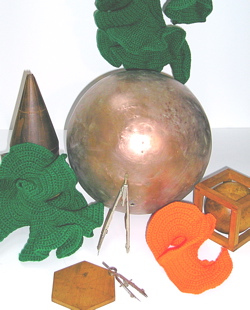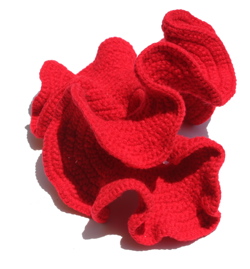Home page for the first
AMS Special Session on Mathematics and Mathematics Education in Fiber Arts
(at the January 2005 Joint Mathematics Meetings in Atlanta, GA). It was held Friday, January 7, 2005, 1:00 p.m.-5:50 p.m. The session was organized by sarah-marie belcastro and Carolyn Yackel. (Information on the 2009 Special Session is here.)
Here's what happened:
1:00 - 1:20: sarah-marie belcastro An Overview of Mathematics in Fiber
Arts, with an Attempt to Answer an Age-Old Question.
abstract
1:30 - 1:50: Mary Shepherd Symmetries in Cross-Stitch.
abstract
2:00 - 2:20: Josh Holden The graph theory of Blackwork embroidery.
abstract Josh's homepage
2:30 - 2:50: Daina Taimina Experiencing and Learning Hyperbolic Geometry
from Crocheted Models.
abstract photos Daina's geometry
textbook page Daina's homepage
3:00 - 3:10: Amy Szczepanski Quilts in the Classroom.
abstract photos
3:15 - 3:25: Susan Goldstine Fortunatus's Purse
abstract
Susan's homepage
3:30 - 3:55: EXHIBIT
photos (and detailed descriptions of exhibit items)
4:00 - 4:10: Jake Wildstrom The Sierpinski Variations: Self-Similar Crochet.
abstract Jake's homepage
Jake's JMM
photos
4:15 - 4:25: Sharon Frechette wasn't able to make it to the JMM, but here's
the abstract for the talk she would have given: Cable
patterns in Aran knitting, and braid groups. Sharon's homepage
Instead, we had question/answer time.
4:30 - 4:50: Lana Holden wasn't able to make it to the JMM either, but she
sent notes with Josh, who delivered her talk for her: Picking up Stitches.
abstract Lana's knitblog
5:00 - 5:20: Dan Isaksen Braid groups and knitting.
abstract Dan's homepage
5:30 - 5:50: Carolyn Yackel Realizing Algebraic Structures Through Knitting.
abstract Carolyn's homepage
And, of course, we hosted the Knitting Network on Thursday, January 6, 8:15
p.m.-9:45 p.m.: photos.
Abstracts and Further Information
sarah-marie belcastro
An Overview of Mathematics in Fiber Arts, with an Attempt to Answer an Age-Old
Question.
The mathematics that arises in fiber arts such as knitting, crocheting, tatting, and quilting includes topology, graph theory, number theory and algebra. This session brings together mathematicians to present a wide variety of mathematics research and work in mathematics education related to the fiber arts. We begin by giving an overview of basic mathematical questions in this area, including:
- What sorts of mathematical objects can be constructed using a particular type of fiber art?
- What sorts of mathematical concepts can be illustrated using a particular type of fiber art?
- What intrinsic mathematics is present in a given fiber art?
- What problems arise in fiber arts that can be answered using mathematics?
Within the above themes, we give examples of work that has been done and issues still to be investigated. This is followed by an attempt to mathematically answer one such question using very basic combinatorics, observations of symmetry, and brute force:
- Of the different knit stitches, why did Western culture settle on the stitch now considered traditional?
...and also followed, of course, by the rest of the talks.
Mary D Shepherd
Symmetries in Cross-Stitch.
Symmetry has been used in the artist endeavors of nearly every culture. Symmetries involving motifs that repeat are used in borders and as backgrounds. There are precisely seven frieze patterns (for borders) and 17 wallpaper patterns. Counted cross-stitch is done in a lattice type layout. Each cross-stitch covers one square, or in some cases half a square (on the diagonal) on some type of even-weave fabric. All the frieze patterns but not all of the 17 wallpaper patterns are possible in counted cross-stitch. This talk will discuss the wallpaper patterns that are possible and the frieze patterns and give examples of several of these symmetries from the author's collection of counted cross-stitch patterns.
Josh Holden (joint work with Lana Holden)
The graph theory of Blackwork embroidery.
Blackwork embroidery, also known as "Spanish stitch'' or "Holbein stitch'', is a needlework technique often associated with Elizabethan England. The patterns used in Blackwork generally are strongly geometric, and are traversed in a way that can be easily described by graph theory. We will characterize these graph traversals and present some algorithms that may be of practical use to needleworkers as well as theoretical interest.
Daina Taimina
Experiencing and Learning Hyperbolic Geometry from Crocheted Models.
First of non-Euclidean geometries - spherical geometry has an advantage that
all of us are very familiar with the sphere since very early age. There are
natural approximate hyperbolic shapes around us - like some lettuce leaves,
wood ear mushrooms, some sea weeds, but we see them not as often as spherical
objects. Therefore starting to teach hyperbolic geometry in the classroom we
do not have this sense of familiarity with the object as in the case of sphere.
How can we help students to feel more familiar with a hyperbolic plane? Using
crocheted hyperbolic planes is an effective way to get familiar with properties
of a hyperbolic plane and to learn mathematics from it. It has been proved that
crocheted hyperbolic plane is an isometric model of a hyperbolic plane. I will
discuss ways of using crocheted models in the classroom and will share experience
how mathematics of a hyperbolic plane can be discovered while playing with them:
what does "straight" on hyperbolic plane means? What is the largest
triangle you can construct on the hyperbolic plane? What is an area of this
triangle? These questions are also discussed in textbook: Henderson,
Taimina, "Experiencing Geometry: Euclidean and Non-Euclidean with History",
3rd ed., Pearson Prentice Hall, 2005.


An additional resource (.pdf): Daina Taimina and David Henderson, "Crocheting the Hyperbolic Plane", Mathematical Intelligencer, Vol. 23, No. 2, pp. 17-28, Spring 2001.
Amy F. Szczepánski
Quilts in the Classroom.
Features of American patchwork quilts have been used as examples in geometry lessons, typically focusing only on the arrangement of colored patches. This talk will present non-traditional quilts designed to illustrate features of Möbius bands to students unfamiliar with the surface. The use of fabric, the quilting design, and other materials were selected to demonstrate the properties of this surface. These will be explained along with mathematical observations about the construction of the quilts.
Susan Goldstine
Fortunatus's Purse.
'You have heard of Fortunatus's Purse, Miladi? Ah, so! Would you be surprised to hear that, with three of these leetle handkerchiefs, you shall make the Purse of Fortunatus, quite soon, quite easily?' --Lewis Carroll
When its mouth is closed, Fortunatus's Purse is the real projective plane, the lesser-known sibling of the Klein bottle. By almost following the directions from Lewis Carroll's Sylvie and Bruno, we may produce a satisfying model of this charming manifold.
D. Jacob Wildstrom
The Sierpinski Variations: Self-Similar Crochet.
Traditional crochet methods such as filet are easily modified to become an ideal medium for the presentation of one-dimensional cellular automata and self-similar geometric figures. This talk will explore both the applications and limitations of this method, and discuss other geometric models for crochet and their possibilities to represent self-similar patterns, as well as the underlying design philosophy which motivates this approach.
Sharon Frechette
Cable patterns in Aran knitting, and braid groups.
Aran knitting has a rich history, originating in the west of Ireland centuries ago, and then developing as an industry in the early twentieth century. Traditional Aran stitches tell a story of family, work, and the landscape. Cable stitches are said to represent fisherman's ropes, and many variations of cables are commonly used. The intricate patterns among the cable's strands can be represented mathematically as braid words. We discuss this mathematical connection, through examples of the most widely used cable variations. Samples of Aran knitting will be included in the special session's Mathematical Fiber Arts Exhibit.
Lana Holden (joint work with Josh Holden)
Picking up stitches.
"Picking up stitches'' is a commonly encountered problem in knitting which occurs in situations such as knitting a sleeve directly onto a sweater from the top down. Since most knit stitch patterns do not produce the same number of rows per inch as stitches per inch, the knitter must determine how to most evenly distribute a specified number of stitches along a vertical edge with an unequal number of rows. We define the concept of "evenly distributed'' as a system of Diophantine equations, present a practical algorithm for determining in which rows to pick up a stitch, and demonstrate that the algorithm produces the unique solution to the problem.
Daniel C Isaksen
Braid groups and knitting.
Understanding knitting in terms of topology is surprisingly subtle. The "unravelability" of knitting means that we can't just apply the traditional notions of knot theory or braid groups. To give the flavor of the difficulties, I'll demonstrate one connection between braid groups and knitting, using "higher derived limits". This is just one small piece of a much larger project to develop a true topological theory of knitting.
Carolyn A. Yackel
Realizing Algebraic Structures Through Knitting.
This talk will have two components. In the first part, we will discuss several different realizations of of the ring Z/(n) in patterned circular knitting. In the second part, we will discuss future directions for exploration by mathematical fiber artists.